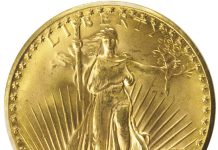Where have all the flowers gone? Better yet, where have all the 2009 Lincoln cents gone?
Halfway through the year, the U.S. Mint had produced nearly 1.375 billion of the special cents marking the 200th anniversary of Abraham Lincoln’s birth and the 100th anniversary of the Lincoln cent itself. That’s quite a bit less than the usual output, judged by recent standards, but still more than enough to supply four of the new coins to every man, woman and child in America.
And that figure represented only the first two coins in the one-year set—so with two more yet to come, the year’s total mintage seemed likely to approach 3 billion.
Why is it, then, that as this issue of COINage—the final issue of 2009—goes to press, I have yet to encounter a single 2009 cent in circulation?
And why do I still have trouble finding a “Westward Journey” Jefferson nickel in pocket change—five years after the last of those special issues, honoring explorers Meriwether Lewis and William Clark, entered the channels of commerce?
I never come across a presidential dollar or Sacagawea dollar either, but those fall into a different category: Most people see no point in carrying or spending $1 coins, so coins of that denomination almost never circulate.
Cents and nickels do see regular use in circulation, though—so why are the special issues so seldom seen?
Obviously, one reason is the fact that they are special. All of the cents and all four Westward Journey nickels were issued during just a single year—and the two Jefferson nickels dated 2005 also bore a one-year-only obverse portrait of Thomas Jefferson. Thus, all eight coins have been set aside by collectors in greater-than-usual quantities.
The incentive to save them was further enhanced by the fact that the total mintage was split in every case—two ways for the 2004 nickels, two ways again for the 2005 nickels and four ways for the 2009 cents. As a result, the individual mintages were less than average for the two series—substantially less for cents dated 2009, when the ailing economy led to reduced demand for new coins in general.
A clogged pipeline also provides part of the explanation for the 2009 cents’ delayed debut. The diminished need for coinage has not only curtailed production but also slowed the new coins’ arrival in circulation. Banks, from the Federal Reserve
to the neighborhood level, are still drawing down supplies of Mint-fresh coins from previous years, so hundreds of millions of Lincoln anniversary cents remain in warehouses.
Then, too, there’s the role of the Coinstar machines in supermarkets across the nation, which offer an easy way for people to exchange mayonnaise jars of “pennies” for more convenient forms of money, replenishing the supply of cents in circulation from mini-hoards that used to sit idle for years. This reduces the need for new coins from the Mint.
Of course, the very absence of 2009 cents from daily commerce serves to reinforce the perception that they are scarce and, by extension, valuable—and that, in turn, causes people to search for them even more aggressively and squirrel them away in even greater numbers when they do make occasional appearances.
Still, I harbor lingering suspicion that the Mint has been doing little or nothing to help make the 2009 cents more widely available. And why should it, when the public’s inability to find the coins in pocket change boosts demand for the rolls being sold—at very substantial markups—by the Mint.
As this is written in mid-October, the Mint’s official Web site is offering two-roll sets of “Professional Life” Lincoln cents (one roll from the Philadelphia Mint and one from Denver) for $8.95—nearly nine times face value. Similar sets of the two previous 2009 cents—the “Birthplace” and “Formative Years” coins—were offered on the Web site earlier in the year, but now are listed there as “Sold Out.” And the fourth and final coin, marking Lincoln’s presidential years, will surely be available there as well.
New coins with new designs are bound to be sought and saved in disproportionately high numbers. The Mint had no similar difficulty, though, in force-feeding the 50-state quarters into circulation within a short time of their production.
How hard has it been trying to do likewise with the special Lincoln cents—before they miss the party for which they were made in the first place?











